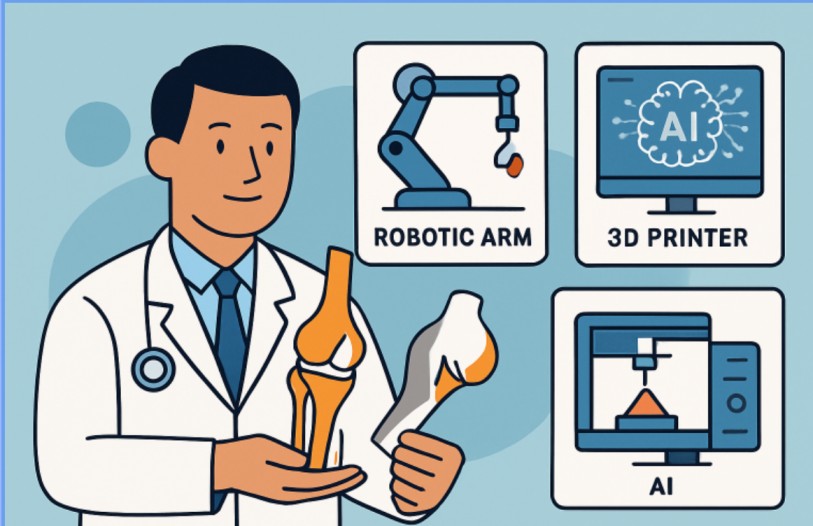Table of Contents
- Minimally Invasive Techniques
- Robot-Assisted Surgeries
- 3D Printing for Custom Implants
- Biologics and Regenerative Medicine
- Artificial Intelligence in Orthopaedics
- Enhanced Recovery After Surgery (ERAS) Protocols
- Patient Considerations
- Conclusion
Orthopaedic surgery continues to advance rapidly, offering patients innovative options that can lead to better outcomes and faster recoveries. Modern techniques and technologies are now transforming the way injuries and disorders of bones, joints, and soft tissues are managed, with many patients seeking out the expertise of experienced orthopedic doctors in Jenks to access these state-of-the-art treatments. Whether you’re facing joint replacement or recovering from a sports injury, understanding these developments can empower you to make well-informed healthcare decisions.
Staying up to date on surgical breakthroughs is crucial for patients who want to maximize treatment outcomes and minimize downtime. The latest orthopaedic surgery innovations range from minimally invasive approaches and robotic guidance to personalized implants—and each comes with unique benefits and considerations. By learning about these cutting-edge solutions, patients can actively participate in their treatment planning, leading to optimal recovery and satisfaction with care.
Minimally Invasive Techniques
The adoption of minimally invasive surgery (MIS) in orthopaedics has revolutionized the way many procedures are performed. By using smaller incisions and advanced visualization tools, surgeons can access and repair damaged tissues with far less disruption to surrounding areas. Arthroscopic surgery, for instance, utilizes tiny cameras and instruments to treat joint problems, resulting in less postoperative pain, fewer scars, and dramatically reduced recovery time compared to traditional open surgery. Despite these advantages, minimally invasive approaches may not be suitable for every condition or patient—surgeons must carefully evaluate each case to choose the best surgical plan.
Robot-Assisted Surgeries
Robotic assistance is becoming increasingly common in operating rooms, particularly for complex, precision-dependent procedures such as knee and hip replacements. Robotic systems help surgeons plan operations with immense accuracy using preoperative imaging and then guide surgical instruments during the procedure. This technology is designed to improve the alignment and placement of implants, thereby enhancing joint function and extending the lifespan of artificial joints. According to WebMD, robot-assisted surgeries may also help reduce revision rates and accelerate rehabilitation, although more research is ongoing on their long-term benefits.
3D Printing for Custom Implants
Personalized medicine has made significant strides thanks to 3D printing, particularly for patients with unique anatomical challenges or those who need custom orthopedic implants. Surgeons can now collaborate with engineers to design and fabricate implants tailored precisely to a patient’s bones, creating better alignment and fit than standardized options. This is especially beneficial for patients undergoing complex joint reconstructions or tumor-related bone replacements. Innovations in 3D printing have accelerated production timelines and improved implant durability, supporting more predictable surgical outcomes, as reported by Mayo Clinic. These developments also enable more individualized treatment plans, tailoring recovery strategies to each patient. As the technology progresses, orthopedic surgeries are expected to become even more precise, with fewer complications.
Biologics and Regenerative Medicine
One of the most exciting frontiers in orthopaedic treatments involves biologics—substances derived from living cells—and regenerative medicine techniques. Stem cell therapies, platelet-rich plasma (PRP), and growth factor injections are increasingly used to accelerate the healing of bones, cartilage, and tendons. These innovations encourage the body’s own repair mechanisms and may offer new hope for chronic or severe injuries that previously required extensive surgeries. As evidence grows, many experts predict biologics will be integral to future musculoskeletal care, whether as stand-alone interventions or adjuncts to surgery.
Artificial Intelligence in Orthopaedics
Artificial intelligence (AI) is driving improvements in both surgical precision and patient care. AI algorithms can analyze large volumes of medical data to assist with diagnosis, predict surgical outcomes, and develop individualized rehabilitation plans. From automated image analysis that detects subtle fractures to machine learning tools that guide surgeons in optimal implant selection, AI is supporting more evidence-based decision-making in orthopaedics.
Enhanced Recovery After Surgery (ERAS) Protocols
Enhanced Recovery After Surgery (ERAS) protocols represent a holistic, patient-centered approach to perioperative care. These protocols integrate elements like preoperative education, optimized anesthesia practices, early mobilization, and targeted nutritional support. The goal is to minimize surgical stress, accelerate healing, and reduce the risk of complications or hospital readmissions.
Patient Considerations
While modern surgical advances are impressive, individual evaluation remains crucial for the safest and most effective results. Patients should discuss all available options with their orthopedic surgeon, taking into account factors such as age, overall health, lifestyle, and the specific diagnosis. Informed, proactive patients often enjoy better post-surgical experiences—so be sure to ask about innovative techniques and how they might apply to your unique case. Open communication and shared decision-making with your medical team can greatly enhance the quality of your care.
Conclusion
The landscape of orthopaedic surgery is evolving rapidly, fueled by technological breakthroughs and a greater emphasis on individualized, evidence-based care. By understanding the latest advancements, patients and their loved ones can feel more confident in navigating orthopedic conditions and pursuing the best possible outcomes in partnership with their healthcare providers.

